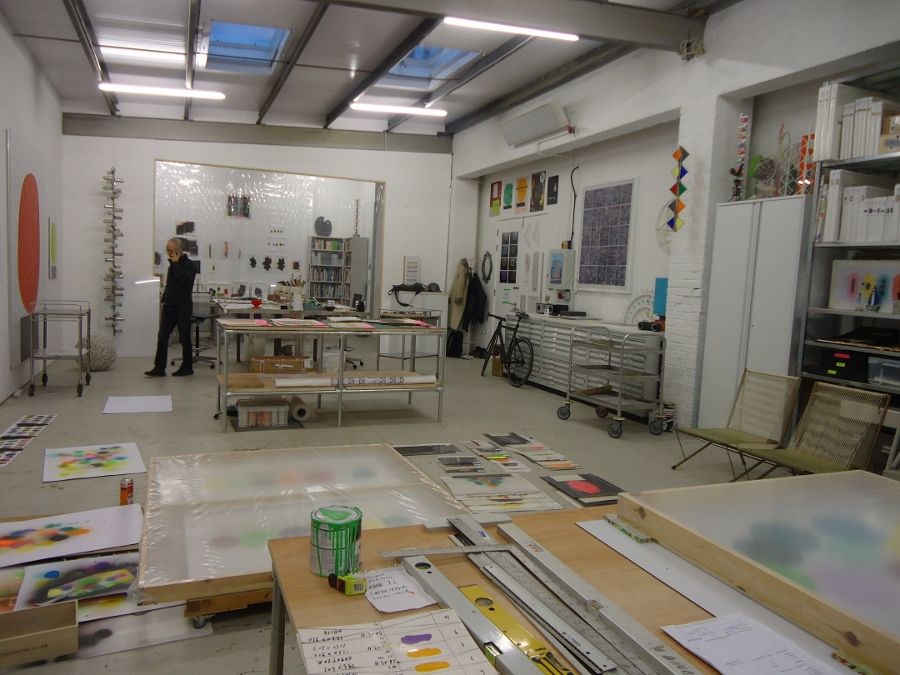
David Batchelor.colour, City And Culture
[et_pb_section bb_built=»1″][et_pb_row][et_pb_column type=»4_4″][et_pb_text _builder_version=»3.2.2″]
David Batchelor (1955) is a Scottish artist based in London who has been working on colour for 25 years. Last December, I had the chance to go back to London and, because of my interest in the colour field, I asked him for a meeting in order to have a talk. Kindly, he accepted it and invited me to his studio, located in east London, which is an industrial area also characterized by the presence of many artists’ studios. His amazing neat 150 m2 studio space is divided in three sections: one for office job, another one for creative purposes and the display of his artwork, and the third one for cutting materials and using sprays.
Thus, by looking and going around his wide studio, Batchelor started talking: “During the first 20 years of my career, it was very difficult to get a good balance among time, space and money. Most of the artists spend their whole lives trying to balance this equation. And this is more about luck and fashion, rather than the quality of the work itself. It is always frustrating”.
We went around the creative section mainly, where he was preparing a solo show for Tehran that would be opened this year in January. In this way, in front of Talisman, he told me how he was accidentally involved with the colour issue during 1993: after a show, in his opinion an unsuccessful one, and the dissatisfaction provoked by that experience, when he turned back to work in the studio he put a piece of pink acrylic over a wooden ledge, and something happened. Without understanding what was exactly going on, the connection between that support and a colour surface was a turning point in his trajectory.
Then, Batchelor remembered that he had grown up as an artist in a period when the artistic peak was dominated by the conceptualism, a movement that did not consider colour as a relevant topic. Because of this context, his small finding (or talisman, as he called it after the event) opened his paths to explore and develop a way of work centred on colour, the city and the abstraction, in two and three dimensions. Thus, his materials began to come mainly from the industry, and they were linked to the cityscape.
[/et_pb_text][et_pb_image _builder_version=»3.2.2″ src=»https://artishockrevista.com/wp-content/uploads/2017/04/DSC02858-900×675.jpg» show_in_lightbox=»on» alt=»David Batchelor’s Studio. Photo: Alejandra Rojas Contreras» title_text=»David Batchelor’s Studio. Photo: Alejandra Rojas Contreras» /][et_pb_image _builder_version=»3.2.2″ src=»https://artishockrevista.com/wp-content/uploads/2017/04/DSC02861-900×675.jpg» show_in_lightbox=»on» alt=»David Batchelor’s Studio. Photo: Alejandra Rojas Contreras» title_text=»David Batchelor’s Studio. Photo: Alejandra Rojas Contreras» /][et_pb_image _builder_version=»3.2.2″ src=»https://artishockrevista.com/wp-content/uploads/2017/04/DSC02864-675×900.jpg» show_in_lightbox=»on» alt=»David Batchelor’s Studio. Photo: Alejandra Rojas Contreras» title_text=»David Batchelor’s Studio. Photo: Alejandra Rojas Contreras» align=»center» /][et_pb_text _builder_version=»3.2.2″]
Batchelor does not consider himself as a sculptor nor a painter. He does not use pigments nor mixes colours; instead, he only juxtaposes them. He never uses oil -“sometimes acrylics, but not much”- and he usually buys his supplies at hardware stores more than at art stores. His palette is diverse; in fact, Batchelor’s selection of colours is linked to cities. “Every city has its own palette and chromatic relationships; for instance, Hong Kong is very colourful”.
Therefore, Magic hour is inspired by the idea of sunset in the city of Las Vegas: “it invites to live the city’s darkness”. Thus, most of times Batchelor’s hues are connected to technology, chemical compounds, plastics, resins and sprays, chosen by an acid, electric and energizing palette. “In my work there is a lot of black, and this is particularly interesting related to other colours because of how we experience colour in the city, which usually appears after the sunset. This is the reason why black and darkness are important for me”.
[/et_pb_text][et_pb_image _builder_version=»3.2.2″ src=»https://artishockrevista.com/wp-content/uploads/2017/04/DB_Magic-Hour-2004-900×604.jpg» show_in_lightbox=»on» alt=»David Batchelor, Magic Hour, 2004-2005, light boxes, fluorescent lamps, acrylic sheets, steel, wires, 308 x 262 x 18 cm. Courtesy of the artist» title_text=»David Batchelor, Magic Hour, 2004-2005, light boxes, fluorescent lamps, acrylic sheets, steel, wires, 308 x 262 x 18 cm. Courtesy of the artist» /][et_pb_text _builder_version=»3.2.2″]
Besides being a recognized artist and professor at the Royal College of Arts and, currently, at Goldsmiths, David Batchelor has also been dedicated to writing, where he reflects about colour in cultural and meaningful aspects. As a result, he has already published nine books about this topic; among them Chromophobia (2000) is highlighted. Also, it explains how in our western culture colour has only had a decorative and mimetic role and it has not been seriously taken into account in academic nor intellectual terms. In this essay, Batchelor indicates that through the Greek legacy and our misinterpretation of white, we have historically associated a state of neatness and elegance to what we called absence of colour. The passing of time and the consequent disappearance of the colour in the classic Greek sculptures and architectonic structures produced this misconception. According to Batchelor, the western aesthetic has privileged a sense of coldness and asepsis due to this legacy, a manner of inertia and death; in other words, a chromophobia. “From the antiquity, colour has been systematically marginalized, injured, diminished and degraded”, being associated to the senses, to the pleasure, and with it, to the cosmetic and superficial concepts, denying in this way all its complexity and richness.
One of the references used by Batchelor to exemplify this marginalization is Charles Blanc (1813-1882), a French theorist from the XIX century, who stated that design (linked to drawing) can be related with masculine and colour with feminine, and that “design should keep its preponderance over colour”. Blanc’s words are even more polemic because of the association with the genre topic, where feminine and chromatic have been dominated by the masculine notion, connected to drawing, shape and definition; in summary, reasoning. This is where Batchelor raises his voice to express the subordination –or even invisibility- that colour has had throughout the history of art, since it has been relegated almost exclusively to a secondary role. Nevertheless, as we already know, the supremacy of reasoning over sensitivity/sensoriality has had a great amount of implications in many other aspects, not only in the artistic ones.
In Chromophobia, Batchelor does not mention Josef Albers, artist and colour theorist, who has been widely recognized for his book Interaction of Colour (1963). Regarding this question, Batchelor affirms that “Albers is more interesting –in colour theories- than Itten or Kandinsky”, but he was not useful for this research case. In this sense, Albers is linked to a more pragmatic and functional methodology of colour. “Surely, for that, he was so knowledgeable and influential in the USA”, he said.
Batchelor’s perception about Albers is that he developed a kind of “practical manual for using colour”, something that he rejected from its bases. As the Scottish artist thinks, “it is necessary to try each colour, it is impossible to make a system for working with colour”, because it will also depend on the different chosen materials. In fact, Batchelor exposes constantly about colour in seminars but he has never carried out workshops to teach how to use colour. “I would say, just try it… systems (in art) do not work. You do not have to be worried about the grammar of colour, primary or complementary colours; you can forget about it. Just use colour! … It sounds like a Nike ad, but just do it” (laughs).
[/et_pb_text][et_pb_image _builder_version=»3.2.2″ src=»https://artishockrevista.com/wp-content/uploads/2017/04/DB_October-cover-2012-13-721×900.jpg» show_in_lightbox=»on» alt=»David Batchelor, October (cover), 2012-2013. Courtesy of the artist» title_text=»David Batchelor, October (cover), 2012-2013. Courtesy of the artist» align=»center» /][et_pb_text _builder_version=»3.2.2″]
In his piece October (2012-2013), Batchelor is quite ironic about the relationship between intellectual-masculine and sensorial-feminine, adding colour and abstract shapes over the first issue of this homonym magazine, that has maybe been the most influential one regarding contemporary art criticism in the last decades.
Hal Foster, Rosalind Krauss and Benjamin Buchloh, among others, write for this magazine. For this reason, it has been very influential and strong, especially in the academic circles, which according to Batchelor “have a chromophobic position”. The irony of his work is based on the fact that, since its first issue in 1976, the October magazine has not reproduced one single coloured image nor written any word about the chromatic topic. In this context, Batchelor’s protest is effective and clear: discontinuing its visual pulchritude with a game of shape and colour, doing an intervention of its pages with colourful circles, triangles y rectangles. In his own words, “this piece was an act of revenge”.
Among the contemporary alive artists that he is interested in, because of their connection with colour and abstraction, he mentions Jim Lambie (Scotland), Melanie Smith (UK), Polly Apfelbaum (USA), Beatriz Milhazes (Brazil) and Jac Leirner (Brazil), who are mainly females.
Beyond all the existent colour theories, being most of them contradictory to each other, Batchelor –both in his oeuvre and his writings- diversifies and makes what is unclassifiable about colour more complex, because experiencing colour will depend on the observer and their culture, especially if we contrast the West and the East. As he stated, “colour is everywhere but we do not understand what it really is… it is an opaque (translucent) language, it is something very familiar and bizarre at the same time, which does not have a possible definition”. Essentially, colour is irreducible to language because it requires experimentation from us.
[/et_pb_text][/et_pb_column][/et_pb_row][/et_pb_section]
También te puede interesar
LA MECÁNICA EMPÍRICA DE DAMIÁN ORTEGA
Tras un abandono total de los recursos y procedimientos propios del medio pictórico, Damián Ortega comienza a experimentar con objetos y sus estructuras. Le interesan su cualidad industrial pero también cómo están hechos y...
PABLO JOSÉ RAMÍREZ: “LANGUAGE HAS ALWAYS BEEN INSCRIBED IN A SYSTEM OF COLONIAL HIERARCHIES”
At the occasion of the exhibition "The Shores of the World", presented at Display, Prague, in June 2018, curator and theoretician of contemporary art Karina Kottová (1984) discussed with the Guatemalan curator Pablo José...
ANTONIO BALLESTER MORENO: ARTE Y PENSAMIENTO HOLÍSTICOS
En marzo pasado tuve la oportunidad de visitar el taller de Antonio Ballester Moreno, en Madrid. Allí conversé con el artista madrileño sobre su última muestra, ¡Vivan los campos libres de España!, un hermoso...



